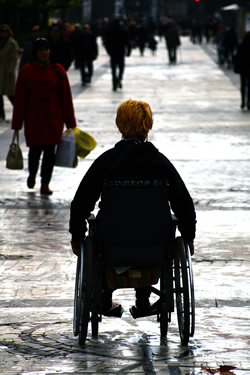Disability in Latin America and the Caribbean
– Public Policy Challenges

Photo: Tunelko/Flickr
According to data from the 2010 round of censuses, disability rates range from 5.1% in Mexico to 23.9% in Brazil, while in the Caribbean the proportion varies between 2.9% in the Bahamas and 6.9% in Aruba. In total, almost 12% of the Latin American and Caribbean population is thought to live with at least one disability, and this represents around 66 million people (according to various statistical sources in the region that are not always comparable).
ECLAC's recently published Social Panorama of Latin America 2012 provides an overview of the living conditions of disabled people in the region. For the first time, the United Nations agency has dedicated a chapter of this annual report to examine the information available on this group in the regional context.
First, ECLAC highlights the need to strengthen processes to harmonize disability measurement in Latin America and the Caribbean, with a view to providing comparable information.
Having reliable statistics is vital, given that the proportion of disabled people is expected to increase due to population ageing and lifestyle changes. According to the report "This rising figure will exert mounting care-related pressure on households, on the networks available and on the limited resources and services provided by the State for care for persons with disabilities". Poverty, armed conflict, urban violence and gender violence are other significant causes of disability.
The region's population is mainly affected by visual or mobility limitations, followed by hearing or speech impairments in Latin America and difficulties with mental function and manual dexterity in the Caribbean (according to census information from 18 countries).
According to the study, people with cognitive and mental deficiencies or a limited capacity for self-care find it the most difficult to integrate economic and social activity. Visual and motor disabilities have the least negative impact on access to education and employment.
Aside from women, the region's most economically and socially vulnerable groups have higher rates of disability. This means older adults, people in rural areas, indigenous or Afro-descendent peoples and low-income groups.
In over half of the region's countries, women have a higher rate of disability than men (particularly from the age of 60). According to the report, this could be due to two reasons.
First, women's greater life expectancy increases their possibility of having a disability resulting from an accident or chronic illness. Second, women live out their old age in more economically vulnerable circumstances, which further increases the risk of any health problem becoming a disability.
Disabled people are overrepresented among the poor. In three Latin American countries - Chile, Costa Rica and Mexico – household surveys carried out in recent years show rising disability rates in the first few income quintiles as people's age increases.
The ECLAC report states "that the impact of contextual factors increases over the life cycle, and that economic and social resources are instrumental in the degree of autonomy people may expect to have in old age. This makes is all the more important to craft policies to counter these income-driven differences in life trajectories".
The report also describes the types of care programmes offered by the region's governments, ranging from home-care services for disabled people and their families to education and employment programmes, direct or subsidized technical assistance and residential adaptations.
The document concludes: "Although a significant percentage of
persons with disabilities in the region live alone, the great
majority receive care and support from immediate family members
through varied shared living arrangements. This situation impacts
heavily, both emotionally and financially, on family well-being, and
highlights the shortfall in the supply of care services provided by
the State, the market and civil society organizations".
| The region's population is mainly affected by visual or mobility limitations, followed by hearing or speech impairments in Latin America and difficulties with mental function and manual dexterity in the Caribbean (according to census information from 18 countries). | |
|
|
|
|
Aside from women, the region's most economically and socially
vulnerable groups have higher rates of disability. This means
older adults, people in rural areas, indigenous or
Afro-descendent peoples and low-income groups. |
|